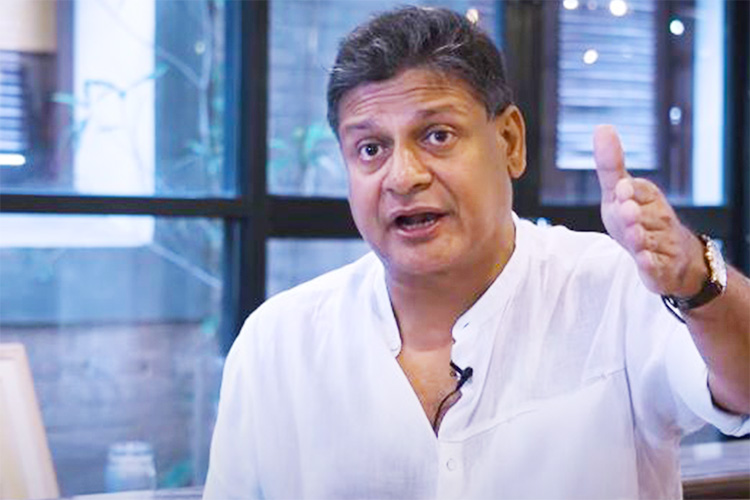SPECIAL REPORT : Part 472
This year’s annual Indian Navy–Sri Lanka Navy bilateral maritime Exercise SLINEX was conducted amidst political turmoil here. The six-day SLINEX, the 10th edition of the series commenced three days after the launch of a public protest campaign near President Gotabaya Rajapaksa’s private residence at Pangiriwatte, Mirihana. The two-phased exercise involved several Indian vessels INS Kiltan (Advanced Anti-Submarine Warfare Corvette) and INS Savitri (Offshore Patrol Vessel), SLNS Gajabahu (Advance Offshore Patrol Vessel/The one in which President Gotabaya Rajapaksa took refuge on July 09) and SLNS Sagara (OPV). In addition, Indian Navy Chetak helicopter and Dornier Maritime Patrol Aircraft and SLAF Dornier and BELL 412 helicopters participated in the exercise. The Exercise featured the Special Forces of the two Navies. The previous edition of SLINEX was conducted in Visakhapatnam from 7-12 March 2022.
By Shamindra Ferdinando
The Indian Defence Research Wing (government website) recently declared that Australia would provide a former Royal Australian Air Force Beechcraft KA 350 King Air (registration A32-673) to Sri Lanka on a request made by India. The KA350 King Air is a modern twin-engine turboprop aircraft.
The story, posted on 16 May, four days after Australian High Commissioner to Sri Lanka, Paul Stephens, officially informed President Ranil Wickremesinghe, who is also the Defence Minister and Commander-in-Chief of the armed forces of the move, was headlined ‘Australia to donate Beechcraft KA 350 to Sri Lanka upon India’s request.’
HC Stephens was accompanied by Deputy High Commissioner Ms. Lalita Kapur, First Secretary Brett Zehnder and Defence Advisor Captain Ian Cain. The meeting took place at the Presidential Secretariat, the scene of violent confrontation between President Gotabaya Rajapaksa’s administration and the protest movement, a year ago.
The Indian website asserted that the Australian move mirrored New Delhi’s bid to strengthen security ties with Sri Lanka as part of its Indian Ocean outreach. According to the website, the deployment is meant to boost Sri Lanka’s sovereign aerial maritime surveillance capability. In terms of the agreement between the two governments, the donor would support the operation of the aircraft for a period of 12 months.
The President’s Media Division (PMD) announced: “The gift of the aircraft is part of the Australian Government’s commitment to strengthening and enhancing the cooperation and collaboration that is the foundation of the strong bilateral relationship between Australia and Sri Lanka. A key focus of this relationship remains the continued cooperation on countering all forms of transnational crime, including drug smuggling, as well as strengthening border management through intelligence sharing and the deterrence, disruption, interception and return of maritime people smuggling ventures under the border security operation, known as Operation Sovereign Borders.”
Operation Sovereign Borders is a high profile military led mission, launched in 2013, to thwart illegal entry of would-be asylum seekers. The change of governments, over the past decade, hasn’t undermined the high profile operation as major political parties are committed to block illegal migration whatever the consequences.
The donation of the aircraft is in line with the understanding the two countries reached following a visit undertaken by Australian Home Affairs Minister Clare O’Neil, from June 19-21 last year, amidst deepening political turmoil here. She met the then President Gotabaya Rajapaksa, Premier Ranil Wickremesinghe, as well as Foreign Minister Prof. G. L. Peiris. A year later, Wickremesinghe is at the helm and Gotabaya Rajapaksa ousted by a US-backed protest campaign, as alleged by former Minister Wimal Weerawansa, a claim denied by the US mission here, but not denied by Speaker Mahinda Yapa Abeywardena, a key protagonist referred to by the accuser.
In April and June 2014, Sri Lanka took delivery of two 38.2 m long Australian patrol boats and they were commissioned as SLNS Mihikatha and SLNS Ratnadeepa. Both vessels are in service today. It would be pertinent to mention that the talks, on the transferring of vessels, were finalized in Colombo when the then Australian Premier Tony Abbott visited Colombo for the Commonwealth Heads of Government of Meeting (CHOGM). The Australian move was made in the wake of the UK going all out against Sri Lanka over the accountability issues.
In the following year, the then Sri Lanka’s shameless government co-sponsored the US–led accountability resolution at the Geneva-based United Nations Human Rights Council (UNHRC) against one’s own country.
India, Australia strategy
In late August last year, Australia announced an unprecedented move to pay for a part of Sri Lankan military’s fuel requirement. Australian High Commissioner in Colombo Paul Stephens tweeted:
“Australia is pleased to be working with India to provide fuel to Sri Lanka’s Navy and Air Force. It will help our long-standing cooperation, against transnational crime, to continue. As Indian Ocean neighbours, all three countries share a commitment to preserving regional security.”
India and Australian joint approach here should be examined against the backdrop of ‘Quad’ strategy in relation to Sri Lanka. However, India pursues its own policy in terms of India’s policy of ‘Neighbourhood First’, ‘Security and Growth for all in the Region (SAGAR),’ as well as ‘Priority One’ partner. ‘Quad’ security alliance meant to counter growing Chinese influence consists of the US, Japan, Australia and India. Sri Lanka has been caught up in the China vs ‘Quad’ battle and Sri Lanka’s dependence on Chinese investments made the situation worse.
The US has included Sri Lanka in its military exercises programme while the other ‘Quad’ member Japan entered into the ‘Comprehensive Partnership’ Agreement in October 2015.
Sri Lanka took delivery of a Dornier 228 maritime patrol aircraft, from India, in mid-August last year. The SLAF declared that India made available the aircraft in response to a request made during the Yahapalana administration (2015-2019). India assured that another Dornier would be supplied within two years after the deployment of the first naval Dornier – a short takeoff and landing multirole light transport aircraft with a turboprop twin-engine, in production since 1981.
An Indian statement said: “The aircraft would act as a force multiplier, enabling Sri Lanka to tackle multiple challenges, such as human and drug trafficking, smuggling and other organized forms of crime, in its coastal waters, more effectively. Induction of the aircraft is timely in view of the current challenges to Sri Lanka’s maritime security.”
Bankrupt Sri Lanka should be grateful for Australian and Indian stepped up assistance at a time the country is experiencing a deepening economic-political-social crisis. Obviously, the crisis here can be a push factor for more Sri Lankans to risk their lives to reach foreign lands. However, the military’s growing dependence on foreign assistance must be a matter for concern for all as there is always the danger of being smothered by the giant neighbour or being unnecessarily dragged into a wider conflict between between the Quad on one side and Russia and China on the other.
Recently, India announced further help to the SLAF. The announcement was made during the four-day official visit of Chief of Air Staff Indian Air Force Air Chief Marshal V. R. Chaudhari earlier this month. The Indian air chief was here on the invitation of SLAF Commander Air Marshal Sudarshana Pathirana.
During the visit, Air Chief Marshal V.R. Chaudhari laid the foundation stone for the construction of the India-Sri Lanka Friendship Auditorium at the Air Force Academy, Trincomalee. In line with New Delhi’s ‘Neighbourhood First Policy,’ the project would be carried out under a 250 mn LKR grant assistance from India. The Indian air chief also donated AN-32 propellers to the SLAF, at the China Bay Air Force Academy, and at the National Defence College training aids were donated to students.
In addition to massive economic assistance provided in the recent past to Sri Lanka struggling on the financial front, the Indian investment, in the defence sector, is rapidly growing.
Deputy High Commissioner Vinod K. Jacob, in late February this year, underscored the Indian investment when he addressed the Indian Navy-trained Sri Lankan military personnel on board Offshore Patrol vessel Sukanya in Colombo. The Indian High Commission quoted Jacob as having stressed that training is the strongest and most enduring pillar of bilateral defence cooperation between India and Sri Lanka. The Deputy High Commissioner declared that India offered approximately 1500 training slots every year, to Sri Lanka, financed through a special programme with an annual allocation of USD 7 million.
Security sector reforms
- Sri Lanka receives Indian Dornier at the BIA in August, 2022
Last week’s midweek piece, titled ‘Blind security reforms: Assurance to US on the size of military’, attracted the attention of quite a number of military officers, including the retired. They queried whether a proper and cohesive assessment has been made before the declaration that the 200,000 plus wartime strength (2009) would be reduced to 135,000 by 2024 and 100,000 by 2030.
One retired General, who had served the infantry and considered one of the foremost battlefield strategists, pointed out that the projected downsizing/right sizing of the Army, should be studied, taking into consideration the current strength. “Do not forget we are already down to 160,000 officers and men,” the retired General said, while another pointed out AWOL (‘absence without leave’ seems to be quite a problem). A retired General Officer Commanding (GoC) of a fighting division on the Vanni front emphasized the need to examine how the proposed reduction would affect post-war deployment and what is the land mass of ‘Eelam State’ (north east districts) and in relation to the drop in ground strength.
In the absence of a cohesive strategy, in relation to vital sectors, including defence, Sri Lanka seems to have neglected matters of utmost importance. Against the backdrop of a worsening situation, regardless of the USD 2.9 bn IMF package, spread over a period of 48 months, Sri Lanka cannot ignore the need to be cautious and be ready to meet any eventuality. In line with the Army, the Navy and Air Force are also to be slimmer and the fact that the downsizing of overall military strength takes place at a time of great political uncertainty and economic upheaval.
In March, Deputy Indian High Commissioner Jacob underscored the importance of Indo-Lanka relations on the basis of five areas of particular significance in the immediate short and medium term objectives.
Addressing Indian and Sri Lankan military personnel, onboard Sukanya, Jacob declared: “First is the potential for economic and financial cooperation by building on the Indian support to the people of Sri Lanka, in 2022, to the tune of USD 4 billion. The Indian HC quoted Jacob as having emphasized that focus could be laid on areas, such as trade, in national currencies, ease of investments and strengthening financial cooperation. “Second, the two sides are working towards increasing air, ferry, digital and energy connectivity. Third, a new type of development cooperation partnership, building on the existing multi-billion portfolio with special emphasis on vulnerable communities, is required. Fourth, both sides need to enhance people to people exchanges, particularly in tourist movements. Fifth, it is essential to strengthen the cultural, religious, music, movie and sporting links for mutual benefit.”
The Indian High Commission media statements present a clear picture of Indo-Lanka developments. A recent Indian High Commission statement that dealt with a visit undertaken by Indian Navy Ship ‘Batti Malv’ to Trincomalee disclosed hitherto unknown information.
Let me reproduce the relevant section from the media statement dated 17 May. The statement issued soon after the vessel departed Trincomalee made an important reference to further Indian support. “The visit of the Indian ship Batti Malv, a fast patrol craft, is also significant in view of the potential for cooperation between India and Sri Lanka for augmenting capabilities of Sri Lanka Navy in similar fast patrol craft for efficiently addressing shared challenges for maritime security in the region,” the High Commission stated.
However, the statement issued by SLN, on that particular ship visit, didn’t make any reference to the possibility of a similar type vessel being made available to Sri Lanka. The locally built 46 m long vessel, crewed by five officers and 54 men, was inducted into the Indian Navy in July 2006, the year Sri Lanka launched a combined forces campaign to eradicate the LTTE.
Since the successful conclusion of the war against the LTTE, in May 2009, India gradually advanced its relationship with a series of military visits at different levels, though the progress was slow. But, over the past several years, there has been a steady enhancement of the relationship which sort of coincided with the deterioration of the national economy.
The Indian Western Fleet visited Colombo and the China-managed Hambantota port, in the second week of March, last year, as Sri Lanka was heading for an unprecedented crisis over the collapse of supply chains.
Four ships of the Western Fleet under the charge of Flag Officer Commanding Western Fleet (FOCWF),
Rear Admiral Sameer Saxena visited Sri Lanka. The indigenous guided missile frigate BRAHMAPUTRA along with frigate TALWAR entered Hambantota port while advanced indigenous destroyer INS CHENNAI and frigate TEG entered Colombo harbour. In spite of being invited to join a reception, onboard INS Chennai, on 10 March, the then President Gotabaya Rajapaksa skipped the event. Instead, Foreign Minister Prof. G.L. Peiris represented the President. The other notable invitee was Speaker Mahinda Yapa Abeyawardena.
A few weeks later, the Indian High Commission had to deny reports of Indian military deployment here in the wake of the eruption of public anger, near President Gotabaya Rajapaksa’s private residence at Pangiriwatte, Mirihana. In brief statements, issued in English, Sinhala and Tamil, the High Commission of India strongly denied, what it called, blatantly false and completely baseless reports in a section of media that India is dispatching its soldiers to Sri Lanka.
The High Commission statement, dated 02 April, 2022, also condemned what it described as irresponsible reporting while expressing the belief those responsible for spreading rumours would desist from doing so.
Delhi’s assistance seemed vast with the Indian Navy actively engaged with Sri Lanka Navy in facilitating engagements, like Deck Landing Practice and Co-pilot experience on indigenous ALHand Sail Training Experience onboard INS Tarangini for SLAF/ SLN personnel in March 2022.
In line with India’s Neighbourhood First Policy, spares for SLNS Sagara, SLCG Suraksha and AN 32 are being provided, on grant basis, by New Delhi, to ensure, what the Indian High Commission called, optimal operational availability of the platform and thereby improve security in the region.
Sri Lanka should take stock of overall foreign military assistance to the post-war military as Sri Lanka faced growing international criticism over accountability issues. Canada has taken the anti-Sri Lanka project to a new extreme by declaring Tamils were subjected to genocide. In a bid to appease powerful Diaspora groups, Canadian parliament has targeted Sri Lanka with the declaration that two former Presidents, Mahinda Rajapaksa and Gotabaya Rajapaksa, are war criminals, is a clear move to inspire countries, with large communities of Sri Lankan origin, to act in a similar fashion. Unfortunately, Sri Lanka has pathetically failed to counter the Canadian project, built on the preposterous accusation that over 40,000 Tamils perished during the final phase of the combined security forces offensive on the Vanni east front. This is despite even UN internal documents placing casualties in the north, during the final phases of fighting, to be in the region of 7000.
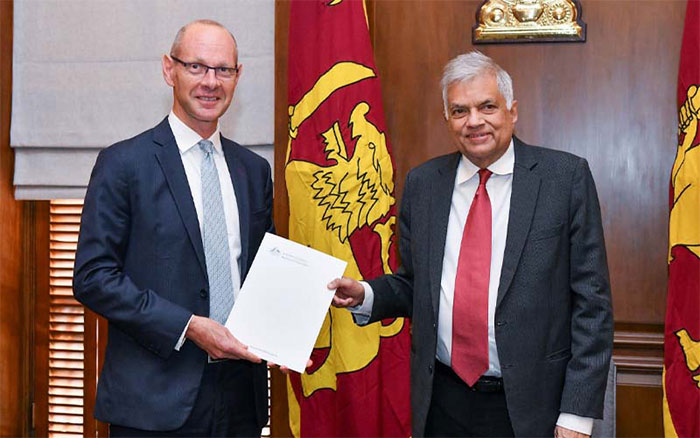
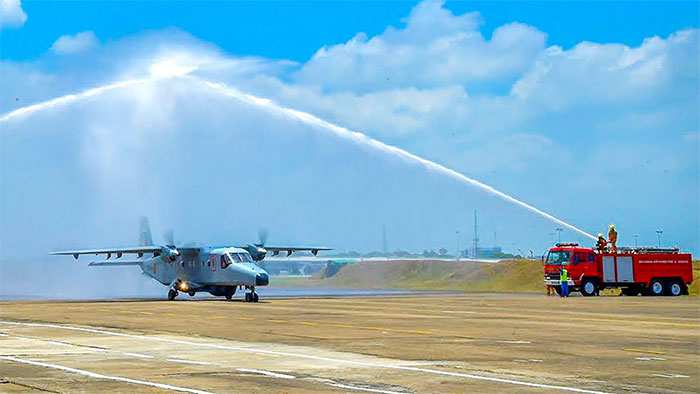
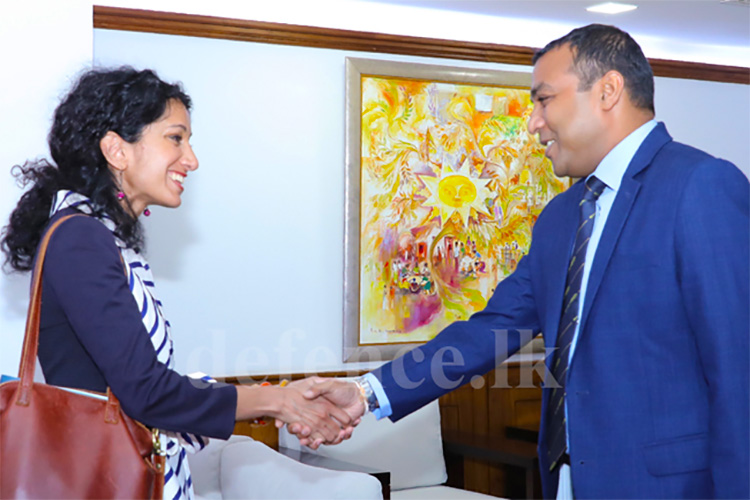
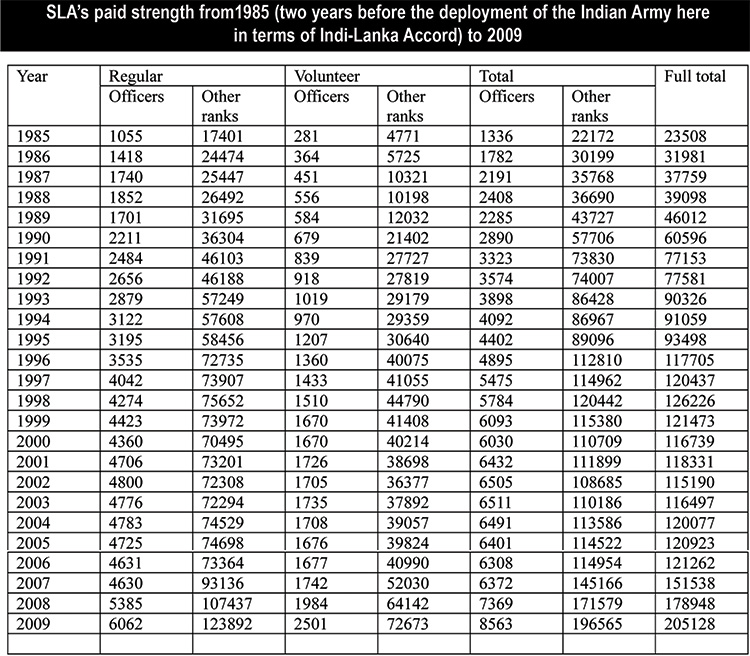 The LTTE couldn’t have been defeated if not for the rapid expansion undertaken during the then Lt. Gen. Sarath Fonseka’s tenure as Commander of the Army (2005-2009). The SLA lacked the wherewithal to sustain a large scale ground offensive while deploying sufficient troops on a holding role. For want of adequate infantry battalions, the SLA couldn’t undertake large scale offensives, simultaneously. But the rapid expansion, since the launching of operations on multiple fronts, in Vanni, from 1997, paid dividends soon enough.
The LTTE couldn’t have been defeated if not for the rapid expansion undertaken during the then Lt. Gen. Sarath Fonseka’s tenure as Commander of the Army (2005-2009). The SLA lacked the wherewithal to sustain a large scale ground offensive while deploying sufficient troops on a holding role. For want of adequate infantry battalions, the SLA couldn’t undertake large scale offensives, simultaneously. But the rapid expansion, since the launching of operations on multiple fronts, in Vanni, from 1997, paid dividends soon enough.